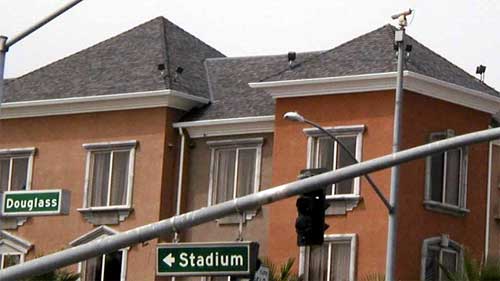
Managing Travel for Planned Special Events
Chapter Four. Regional
and Local Coordination
Page 1 of 4

Figure 4-1. Closed-Circuit Television Camera on a Stadium Access Road
Purpose 
This chapter covers the first of five phases of managing travel for planned special events. Program planning for planned special events involves activities unrelated to a specific event. This level of advance planning involves the participation and coordination of stakeholders having an oversight role in addition to agencies directly responsible for event operations planning. Products of program planning include establishing new institutional frameworks, policies, and legislation to monitor, regulate, and evaluate future planned special events. Stakeholders utilize program planning initiatives to more efficiently and effectively complete event operations planning, implementation activities, day-of-event activities, and post-event activities for individual, future planned special events. In turn, post-event activities (e.g., participant evaluation, stakeholder debriefing meeting, evaluation report) performed for specific special events provide valuable input for on-going program planning activities in a region or jurisdiction.
This chapter presents key elements of program planning on a regional level and local level that facilitate improved planning and management of travel for future planned special events affecting multiple jurisdictions or a single municipality, respectively. It also describes strategic infrastructure support considerations for improved traffic management and dissemination of traveler information. The occurrence of major or recurring planned special events often serve as a platform for stakeholders to assess new services and infrastructure proposed for a single or series of special events in the context of supporting: (1) all special planned special events in a region and (2) day-to-day transportation system operations.
Introduction 
This chapter presents program planning activities conducted for future planned special events. These activities include the development, by oversight team stakeholders, of policies, programs, and regulations that collectively comprise a special event program for managing all planned special events in a region. Program planning for regional planned special events requires an institutional framework for generating and managing successful programs and initiatives. Some key topics and initiatives addressed in this section include:
- Role of oversight stakeholders, including (1) how their involvement is coordinated, (2) what are the programs and initiatives that facilitate the planning and operation of planned special events, and (3) how special events planning is integrated with other ongoing transportation programs.
- Support necessary from a policy perspective. On a policy level, interagency agreements permit those involved to work together. At times, legislation may be needed to allow agencies to go beyond their current activities into areas not currently permitted legally.
- Regional planned special events programs. In many instances, the impact of planned special events will extend beyond the jurisdiction of a single agency. In this section, the key elements of regional planned special events programs will be identified, the scope and benefits of such programs will be noted, and stakeholder organization will be explained. Also covered in this section is how such programs are developed, and just as important, sustained. Services and initiatives that go into regional planned special events management will be explained and the institutional issues, likely to be encountered, will be noted.
- Government agency permitting and regulation framework. The permitting process can identify many of the basic elements of the special event such as its timing, location and expected number of event patrons. Through a carefully constructed permitting process, transportation and public safety agencies can achieve a better sense of what resources these stakeholders need to handle the event. This section will provide an overview of the permit process, what the process includes, the components of a detailed application, and the associated requirements including recovery of public stakeholder expenses.
- Infrastructure support. Technology can be used for a variety of purposes, including communication among stakeholders and to the public in addition to transportation system management and monitoring during events. Paying for these activities is covered in the subsection on funding sources.
Planned Special Events Traffic Management | Privacy Policy